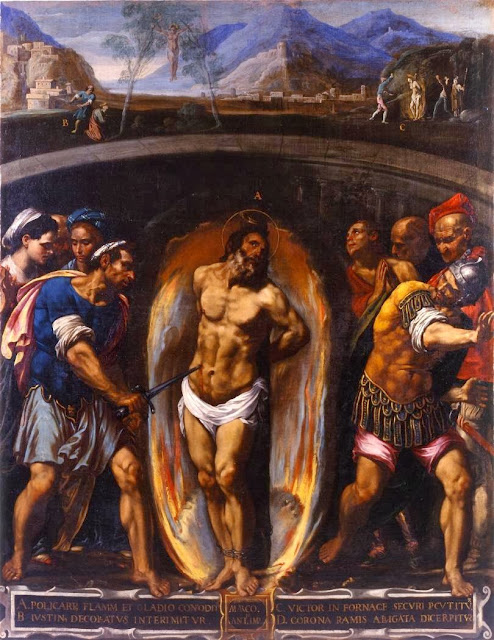Master of the Saint Bartholomew Altarpiece (fl. 1470–1510)
Saint Bartholomew Altarpiece: Bartholomew the Apostle, Agnes of Rome, Saint Cecilia, circa 1503
Oil on panel
Alte Pinakothek Museum, Munich, Germany
Agnes is depicted in art with a lamb, evoking her name which is based on the Latin word for "lamb". She is also shown with a martyr's palm.
Agnes of Rome (c. 291 – c. 304) was a popular saint
about whom little is known, Agnes is said to have been a beautiful, wealthy
Roman maiden who had, in childhood, dedicated herself to God.
Circle Simon Vouet
Saint Agnes
Oil on canvas
75.5 by 60.9 cm.; 29 3/4 by 24 in
Private collection
Simon Vouet
Saint Agnes, c.1626
Oil on canvas
37 x 29 in 94 x 75.5 cm
Private collection
Simon Vouet (9 January 1590 – 30 June
1649) was a French
painter and draftsman, who today is perhaps best remembered for helping to
introduce the Italian Baroque style of painting to France. More on Simon Vouet
Some say that a
rejected suitor betrayed her to authorities; others say that she was asked at
13 to sacrifice to the gods and marry, both of which she refused. Legends tell
of her being thrown into a brothel, where her purity was miraculously
preserved.
Alessandro Turchi (1578–1649)
Saint Agnes Protected by an Angel, circa 1620
Oil on marble (polished marble)
Height: 13 ″ (33 cm); Width: 16.7 ″ (42.5 cm)
Los Angeles County Museum of Art
Alessandro Turchi (1578 – 22 January 1649) was an
Italian painter of the early Baroque, born and active mainly in Verona, and
moving late in life to Rome. He also went by the name Alessandro Veronese or
the nickname L'Orbetto.
Turchi
initially trained with Felice Riccio (il Brusasorci) in Verona. By 1603, he was
working as independent painter. Turchi painted the organ shutters for the
Accademia Filarmonica of Verona. When Brusasorci died in 1605, Turchi and
Pasquale Ottino completed a series of their deceased master's canvases. On
leaving the school of Riccio, he went to Venice, where he worked for a time
under Carlo Cagliari.
By 1616,
Turchi traveled to Rome and participated in the fresco decoration depicting the
Gathering of Manna for the Sala Reggia of the Quirinal Palace. In competition
with Andrea Sacchi and Pietro da Cortona, he painted some pictures in the
church of Santa Maria della Concezione dei Cappuccini. In 1619, he sent an
altarpiece of the 40 martyrs for the Chapel of the Innocents in the church of
Santo Stefano, Verona, to hang next to paintings by Pasquale Ottino and
Marcantonio Bassetti. He was much employed on cabinet pictures, representing
historical subjects, which he frequently painted on black marble.
In 1637, with the sponsorship of the cardinal
Francesco Barberini, he became Principe or director of the Accademia di San
Luca. In 1638, he joined the papal guild of artists, called the Pontifical
Academy of Fine Arts and Letters of the Virtuosi al Pantheon. He died in Rome. More on Alessandro Turchi
Having escaped that fate, she was martyred. In the IV Century,
Constantia, the daughter of Constantine, built a basilica on the site of her
tomb. St. Ambrose wrote about Agnes in De virginitate, and Damasus I wrote an
epitaph for her. Prudentius composed a hymn in her honor. Her emblem in art is
the lamb because of the similarity between her name and the Latin word for
lamb, agnus.
Jusepe de Ribera
St. Agnes in Prison, c. 1641
152 x 203 cm
Private collection
José de Ribera (January 12, 1591 –
September 2, 1652) was a Spanish
Tenebrist painter and printmaker, better known as Jusepe de Ribera. He also was
called Lo Spagnoletto ("the Little Spaniard") by his contemporaries
and early writers. Ribera was a leading painter of the Spanish school, although
his mature work was all done in Italy. More on José de Ribera
The legend cannot be proven true, and many details of the fifth century Acts of Saint Agnes are open to criticism likely full of elaboration, though substantially the circumstances of her martyrdom are authentic. Archaeological evidence indicates that a young girl of about thirteen years of age, a virgin named Agnes, was martyred in Rome and honoured for her sacrifice. A church was built over her tomb, and her relics venerated.
A beautiful young girl of wealthy family, Agnes had many suitors of high rank, and the young men, slighted by her resolute devotion to religious purity, submitted her name to the authorities as a follower of Christianity. More on Agnes of Rome
Please visit my other blogs: Art
Collector, Mythology, Marine
Art, Portrait of a Lady, The
Orientalist, Art of the Nude and The
Canals of Venice, Middle
East Artists, 365
Saints and 365 Days, also visit my Boards on Pinterest
Images are copyright of their respective owners, assignees or others.
Some Images may be subject to copyright
I don't own any of these images - credit is always given when due unless
it is unknown to me. if I post your images without your permission, please tell
me.
I do not sell art, art prints, framed posters or reproductions. Ads are
shown only to compensate the hosting expenses.
If you enjoyed this post, please share with friends and family.
Thank you for visiting my blog and also for liking its posts and pages.
Please note that the content of this post primarily consists of articles
available from Wikipedia or other free sources online.





























